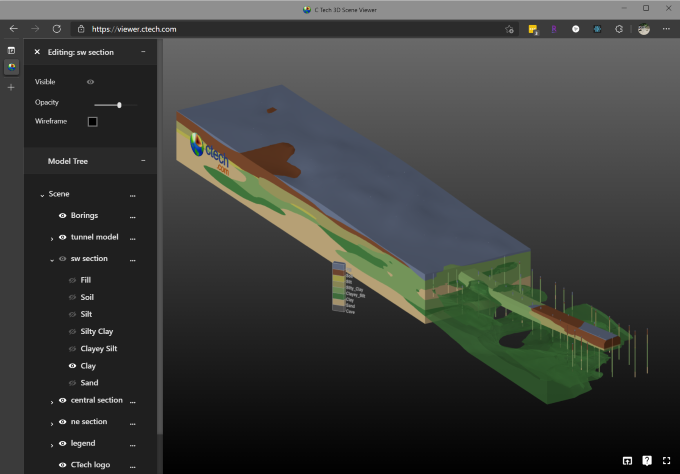Earth Volumetric Studio 2021.4.2: The April 2021 release of EVS introduces support for C Tech Web Scenes. It also brings many improvements and bug fixes, and is a highly recommended upgrade for all users.
Major improvements since the beta include:
- CTWS files created in 2021.4.2 now allow for interactive probing for coordinates (via double click or ctrl+click) on https://viewer.ctech.com.
- Objects in model with analytical data also show values.
- Objects in model with Stratigraphy or Lithology show the material or layer (cell set name)
- You can experiment and see the new features using the Coastal Facility model on https://ctech.com
- Better migration of old (2020 or earlier) applications to 2021.4.2.
- Intersection, union, and plume modules have been improved, and are now faster, provide better progress while running, and can be canceled while executing.
Note: A new Studio Projects release, updated for 2021.4.2 and including many sample applications will follow shortly.
This release includes functionality for creating C Tech Web Scenes, a single file deliverable viewable in a browser with no installation required.

We recommend all users upgrade to EVS 2021.4.2.
This is a significant release in terms of new features and changes. This will allow you to load your existing apps and make C Tech Web Scenes (*.ctws), which can be viewed at https://viewer.ctech.com.
Note that there are breaking changes in this release.
Please see below for more details on the changes and improvements in this release. We will be creating documentation and videos demonstrating more of these changes and issues in the upcoming weeks.
Thank you,
Reed Copsey, Jr.
CTO
Significant changes and improvements in 2021.4 Beta:
- Backward and Forward Compatibility
- Applications created in version 2020.12 (or earlier) can be read by 2021 EVS releases, subject to the issues discussed below.
- However, applications created (or resaved) in 2021 releases or later cannot be read by any release before 2021.
- Application Origin Concepts
- We have implemented a new concept we call “Application Origin” which completely resolves precision issues (https://www.ctech.com/
precision-issues-in-evs/). This was required to make web based viewing possible due to WebGL requirements and limitations. Please understand that this required internal modifications to nearly all modules. There are many consequences to this which will both improve the quality of your outputs, but will occasionally require application modifications. - Objects which are intended to be at or near the spatial origin (0,0,0) must use load_glyph or,
- You must turn off “Use Application Origin” (new toggle) in modules like read_cad, read_vector_gis & read_lines
- Examples of such objects are:
- Sphere (ellipsoid) glyph used for anisotropic variography display
- Tunnel cross-section sketches (lines)
- We have implemented a new concept we call “Application Origin” which completely resolves precision issues (https://www.ctech.com/
- New methodology for setting the coloring of Objects
- Data selection (node/cell) and data component are in the (red port) Object Properties for nearly all modules with red ports
- post_samples is a notable exception because it outputs a group object with multiple coloring methods
- Data selection (node/cell) and data component are in the (red port) Object Properties for nearly all modules with red ports
- The new export_scene module & related issues
- export_scene connects via the purple port and writes all objects in your view as a “C Tech Web Scene” (*.ctws), a single file which you and your customers can load and view at: https://viewer.ctech.com/
- Anything in the 2D overlay (Forward Facing Text, 2D legends, add_logo, etc.) will not be written (yet).
- We strongly recommend renaming of modules (connected to the viewer) to create a more appropriate Model Tree for C Tech Web Scenes. We’ve added two new methods to rename (since you’ll be doing it more often):
- Right Click on module
- Rename icon in the module’s properties
- Look for many example applications with “.ctws” in their names when we release a new April 2021 Studio Projects
- export_scene connects via the purple port and writes all objects in your view as a “C Tech Web Scene” (*.ctws), a single file which you and your customers can load and view at: https://viewer.ctech.com/
- Modules which should be used differently
- axes: Can connect via purple port only. No other connection required
- titles: Can connect via purple port only. The only other connection which may be required would be string input
- place_text: Can connect via purple port only. No other connection required
- north: Can connect via purple port only. No other connection required
- Modules which must be used differently (not fully backwards compatible):
- Straighten to 2D functionality in post_samples and thin_fence now places straightened objects at the Application Origin vs. (0,0,0)
- Requires changing viewer view (Fit or Top)
- Works in your 3D view with 3D objects since it is anchored at the Application Origin, and not at (0,0,0) in your model’s coordinate system
- axes: X axis coordinates begin at your Application Origin
- This can be overridden with settings in axes
- texture_geology now works only on cell sets (not cell data)
- This may require more images since you may have more cell sets than Material IDs
- If multiple cell sets will share a single texture image, consider using packaging which will allow you to drag-&-drop files for quicker reuse
- Image file order and number of images will need changing in most applications
- Underlying data colors cannot be passed through textures without making them transparent and having a coincident colored object.
- Straighten to 2D functionality in post_samples and thin_fence now places straightened objects at the Application Origin vs. (0,0,0)
